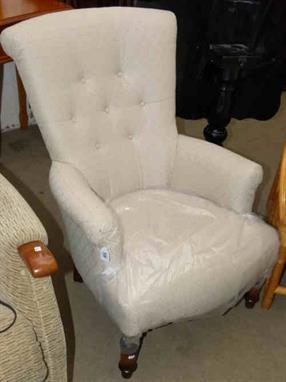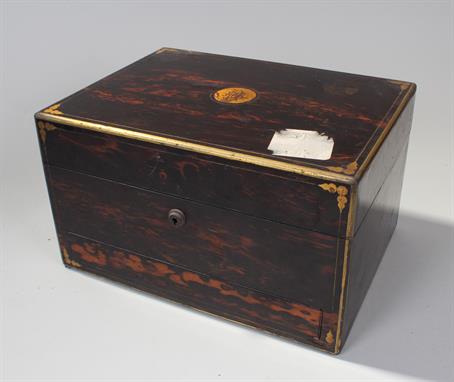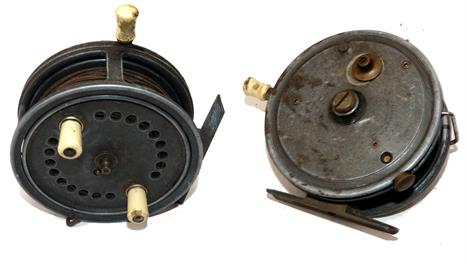** A FINE SILESIAN WHEEL-LOCK BIRDING RIFLE (TSCHINKE), DATED 1677 with octagonal swamped sighted barrel rifled with six narrow grooves, punched with a star-shaped design at the muzzle, signed by the barrel smith `AK` and dated over the breech, angular tang engraved with the letter `L`, engraved flat lock of characteristic form, decorated with bold scrolls, fitted with external wheel retained by a bracket, engraved flash-guard, engraved dog, engraved pan-cover with button release, and applied with engraved brass plaques over the wheel bracket, the main spring and the dog spring, fruitwood full stock profusely inlaid with engraved staghorn plaques including hounds, rabbits and ball flowers amongst scrolling staghorn tendrils enriched with ball flowers and pellets, all between staghorn lines (the inlay with minor restorations and small losses), the underside of the stock decorated with further designs including a stag and a wild boar, butt of characteristic form inlaid en suite including a unicorn on the cheek-piece and with patchbox with sliding cover, iron trigger-guard shaped for the fingers, engraved horn butt-cap decorated with a rabbit, engraved staghorn ramrod-pipe, engraved staghorn fore-end cap, and associated ramrod 95.5 cm; 37 5/8 in barrel
We found 110990 price guide item(s) matching your search
There are 110990 lots that match your search criteria. Subscribe now to get instant access to the full price guide service.
Click here to subscribe- List
- Grid
-
110990 item(s)/page
AN OFFICER`S UNIFORM OF THE MADRAS MEDICAL SERVICE CIRCA 1900 BY HOBSON & SONS, LEXINGTON STREET Blue Full Dress tunic, edged with scarlet piping, with black velvet facings. Gold "Staff" lace to collar and pointed cuffs. Twisted gold shoulder-cords bearing Colonel`s KC rank-badges. Richly-gilt buttons bearing QVC above star and circlet inscribed `MADRAS MEDICAL SERVICE`. Label in lining to Lt Col W Molesworth; a mess jacket by same maker, with black velvet upright collar and cuffs, edged all round with gold lace, gilt studs to front and twisted shoulder-cords bearing KC in embroidery; companion scarlet waistcoat, with high collar, studs to front, and gold Russia edging and pocket-ornamentation; a blue double-breasted greatcoat with black velvet stand-and-fall collar and scarlet lining. Six buttons in each row in front, short belt and skirt-slashes to back and metal rank-badges to shoulder-straps (one button and some rank-badges missing, minor moth); a short blue cape with leather strap fastening to collar and four small gilt buttons to front; a black leather waistbelt with double stripe of gold embroidery, the outer element of the circular clasp bearing laurel leaves, the inner part mounted with QVC royal crest in white metal, the belt complete with matching sword-slings, and with rings for sabretache-slings (sabretache-slings not present); a companion black leather pouch belt with triple row of gold embroidery and ornate brass (originally gilt) buckle, tip and slide, companion folding pouch with gold-embroidered black leather flap bearing gilt `VRI` in script below QVC (pocket missing); another pouch belt, similar to previous item, but with more substantial pouch, the flap mounted with the Imperial crown above `VRI`; and a pair of khaki drill shoulder-straps, fitted with brass King`s crowns. (9)
A VICTORIAN INFANTRY OFFICER`S LEVEE DRESS ACCOUTREMENTS CIRCA 1900 A fitted metal case containing a gold-laced waist belt and slings, the gilt clasp bearing the Royal Crest in white metal; gold and crimson striped shoulder-sash; a pair of brass swan-necked box-spurs; a pair of twisted gold shoulder-cords bearing Colonel`s rank-badges in silver embroidery (one lacking button); and a pair of plaited and winged gold shoulder-cords with gilt buttons of the 12th Madras Regiment
A .800 CALIBRE GERMAN (SAXON) WHEEL-LOCK RAMPART GUN, DATED 1685 with massive swamped octagonal sighted barrel rifled with seven grooves (surface rust), moulded at the breech and numbered `1`, dated flat lock retained by two side nails, struck with the mark of Hans Loeffler (Neue Støckel 716), fitted with external wheel with engraved gilt cover, sliding pan-cover with gilt acorn finial released by a brass button engraved with a grotesque, moulded dog and dog spring with filed scrolls, double set trigger, full stock flattened beneath the fore-end for resting, impressed `6` behind the tang, large butt of fish tail form, hollowed at the top, brass mounts comprising shaped trigger-guard with acorn finial en suite with the pan-cover, butt-plate, a pair of foliate horn side nail washers, fore-end cap and a pair of ramrod-pipes of contrasting horn 90.3 cm 35 5/8 in barrel Hans Loeffler is recorded in Ruhla, Saxony circa 1683-1714.
A FINE AND RARE .600 CALIBRE FRENCH PRESENTATION FLINTLOCK RIFLED CARBINE BY BOUTET, DIRECTEUR ARTISTE, MANUFACTURE À VERSAILLES, NO. 277, CIRCA 1800-05 with blued swamped octagonal polygroove rifled barrel, fitted with windage adjustable fore-sight on a punched and gilt bed, signed in italics on the left of the breech `Boutet Directeur Artiste No. 277`, inscribed on the right `Manufre à Versailles` and stamped beneath with the control mark of Daniel Boussavy, and the abbreviated italic inscription `Manu` and `V lles.` in italic, gold lined oval vent, the top of the breech chiselled with a garland of flowers beneath a triangular panel filled with a flower head, all on a punched and gilt contrasting ground, stamped with a series of marks including `Boutet` in miniscules, and `NB` (Neue Støckel 95), fitted with blued back-sight of two folding leaves, engraved tang decorated with neo-classical ornament including a pair of entwined serpents enclosing a smoking urn, stepped lock with moulded borders (small dents), signed `Boutet Directeur Artiste`, chiselled with beadwork along the step, fitted with engraved cock decorated with a garland of flowers, gold-lined pan engraved with a pair of volutes, with scrolling rear fence, blued steel spring with roller, engraved button safety, and detents, steel engraved en suite with the pan, set trigger, figured walnut full stock, impressed `47`, carved with a panel of fine chequering over the fore-end and the grip, carved with a moulding along the length of the barrel on each side and inlaid with a running design of silver foliage beneath, the muzzle carved with anthemion and neoclassical foliage (one very small repaired crack), further foliage about the rear ramrod-pipe and the lock, each enriched with further panels of leafy conventional foliage in engraved silver, the tang enclosed with a raised fluted moulding and a pair of neo classical demi flowers, the butt with carved raised cheek-piece inset with a large pierced and engraved silver flowerhead, the base of the butt encircled by a broad panel of silver pierced chased and engraved with geometric panels filled with scale pattern and a band of waves (a small area with minor lifting), burnished steel mounts comprising chiselled trigger-guard with a neo-classical flaming urn finial, the bow with foliage at each end and an engraved rear finial, the rear portion continued by a scrolling panel of pierced ebony decorated with neo classical foliage (very small chips), two-piece vestigial side-plate engraved with a garland and a flowerhead respectively, the right enclosed by two engraved silver dragons breathing thunder-bolts, butt-cap chiselled with an urn on the tang, rear ramrod-pipe chiselled with a leafy garland and beadwork, four further faceted ramrod-pipes with beadwork mouldings, contemporary horn-tipped wooden ramrod, and remaining in very good condition throughout 70.5 cm; 27 ¾ in barrel The Annuaire of the Versailles Manufactory for this period includes the following entry: Prince de Bade - Carab. doub. détente, acier cis. damasq., placage argent, fr. 6075 AN XI (September 23, 1802 to September 23, 1803) The use of silver inlay in the stock and steel mounts, as opposed to silver mounts, might suggest presentation to a high ranking military officer. The proximity to France of the territories of Charles-Frederick, Margrave of Baden (1756-1811), together with his initial opposition to the French revolution and its effects, resulted in the devastation of Baden by French armies in the mid-1790s. Thereafter, having indemnified France and ceded some territory to that republic, Baden remained under the sway of its powerful neighbour until 1813. In November 1802, the margrave - having lost his eldest son in the previous year and clearly prescient regarding the ambitions of Napoleon - wrote France`s First Consul a fulsome letter in which he thanked Napoleon for his continuing protection and assured him of his admiration and loyalty: significantly, he chose to send his third - and favourite - son, Prince Louis, to France with the letter. In April 1806, by which time the margrave had become an electoral prince, ties between Baden and France were strengthened by the arranged marriage of the elector`s grandson and heir, Prince Charles, to the Emperor Napoleon`s adopted niece and newly created imperial princess, Stéphanie de Beauharnais. The elevation of the elector to the rank of grand-duke - an elevation approved and arranged by Napoleon - followed in July 1806 and further bound Baden to the fortunes of Napoleonic France. Elements of Baden`s small army served alongside that of France in several campaigns between 1805 and 1812: against Austria in 1805, Prussia in 1806, Britain (in Spain) in 1809 and Russia in 1812. Prince Charles, heir to his grandfather after 1801 and husband of Napoleon`s adopted niece from April 1806, was welcomed by personal letter into Napoleon`s military entourage in September 1806 - `J`approve le désir que vous avez de faire la guerre`. The prince was summoned to meet Napoleon at Bamberg early the following month and was with the French army at its decisive victory over that of Prussia at Jena on 14th October 1806, after which Napoleon wrote to Prince Charles`s widowed mother to reassure her that her son had done well at his first battle - `...il s`est bien comporté à la bataille et supporte bien la fatigue`. In 1807, Prince Charles commanded the Baden contingent at the siege of Danzig and continued on active service until 1808. Succeeding his grandfather in 1811, Charles maintained Baden`s support for France until the battle of Leipzig in 1813 demonstrated that the tide of war was no longer flowing in France`s favour. The political, military and personal ties that bound Baden to France from the late 1790s until 1813 must account for the existence of this carbine in the descendant family of the Grand Duke of Baden. It is possible that it originally belonged either to Prince Louis, who visited Napoleon at his father`s behest in 1802 and remained in Paris for some years, or to his nephew, Prince Charles, who served alongside Napoleon in his campaigns between 1806 and 1808: given the martial qualities of the weapon, the latter seems the most likely of the two princes to have been its original owner. Nicolas-Noël Boutet (1761-1833) the distinguished maker of armes de luxe inherited the position of gunmaker to Louis XIV from his father-in-law, Pierre de Sainte (active 1747-88). In 1792 he became technical Director at the new Versailles Manufactory and in 1800 rose to Directeur Artiste with overall control. He held this position until the closure of the manufactory in 1818. Boutet died fifteen years later in poverty, his career having survived six French Political regimes. Daniel Bouyssay was controller at the Versailles Manufactory from Year II (1793-4) until Year XIV (1805).
A FINE .700 CALIBRE SILVER-MOUNTED FLINTLOCK SPORTING RIFLE BY JOVER & SON, LONDON, LONDON PROOF MARKS, LONDON SILVER MARKS 1785, MAKER`S MARK M.B. with browned twist swamped barrel rifled with nine grooves, fitted with silver fore-sight and case-hardened steel back-sight, the breech signed `Jover & Son London` in gold block capitals, inlaid with an engraved gold line, gold lined vent and stamped with the barrelsmith`s mark of William (1) Jover beneath, finely engraved tang decorated with scrolls enclosing flowers and foliage, stepped lock signed finely engraved with a stag on the tail, a sunburst and a trophy-of-arms enclosing a signed gold oval beneath the pan, fitted with cock engraved en suite, gold-lined semi-rainproof pan, engraved steel incorporating an additional separate blued pan-cover released by a blued button on the outside, blued steel spring fitted with rollers for both the steel and the pan-cover, sliding safety-catch, the inside with blued steel fittings and detents retained by a pierced circular plate, set trigger, highly figured walnut half-stock, applied with an engraved silver panel on the left of the breech, inlaid in silver with a stag hunting scene and a vacant escutcheon opposite the lock (the hound`s head missing), carved with a rococo moulding about the tang, finely chequered grip, the butt with raised cheek-piece on the left and patchbox with silver cover on the right, the latter released by an engraved silver button on the butt-cap and enclosed by a silver framework surmounted by an elaborate trophy-of-arms, full silver mounts comprising trigger-guard with a trophy-of-hunting on the bow, elaborate pineapple finial and scrolling rear terminal with a rococo flower, butt-plate decorated with garlands of flowers and a reclining stag on the tang, two pairs of engraved barrel bolt escutcheons, and rear ramrod-pipe, two further browned steel ramrod-pipes, horn fore-end cap, and original horn-tipped ramrod with slotted steel terminal 92 cm; 36 ¼ in barrel William Jover & Son worked in partnership circa 1784-96.
A Dark Brown Mink Jacket, labeled, The Fur Salon, Kendals, lined in black and gold coloured thread brocade fabric, cross over front lapel fastening with large circular single fur covered button, three quarter length sleeves and a blonde otter fur jacket, labeled Ellis Barker Furs, Chester , two button fastening, front pockets and side splits (2)
Walt Disney, `The Black Hole` figures, to include a kit model of `Maximillian` in original box and cellophane wrap, two further Maximillian figures, one unopened on card with hook tag still intact, VIN cent LF 396 figures, boxed and loose robots and space figures, key rings, button badges, etc
A part set of white gold and mother-of-pearl studs and cufflinks, comprising a pair of cufflinks and four dress buttons (the pair of studs lacking), with a case, five gold and blue enamel mounted circular dress buttons with mother-of-pearl centres (the sixth button lacking), with a case, a gold dress stud, and a pair of unmarked oval cufflinks, with a case.
A late Victorian violin `made and presented to H.R.H. Prince Arthur of Connaught... by Robert Howe. 1890`, bearing label to interior inscribed `R. Howe Windsor Castle 1889`, the two-piece back bearing stamp `R. Howe`, length of back excluding button 33.7cm, the oak case with an applied silver plaque, engraved `H.R.H Prince Arthur of Connaught 1890`, the interior with an applied vellum panel, inscribed `This case is made from a piece of old oak taken out of the Round Tower... The upper table of the violin in this case was made from an old door of Windsor Castle... Both the case and Violin were made and presented to H.R.H Prince Arthur of Connaught upon his return from India...`, together with a silver mounted bow. Note: Prince Arthur was born the seventh child and third son of Queen Victoria. He was the Commander-in-Chief of the Bombay Army from December 1886 to March 1890.
Gentlemen's gold (9ct) open face pocket watch with Swiss fifteen jewel button-wind movement, white enamel dial with subsidiary seconds and blued steel hands, in gold 9ct) case, import hallmarks (London 1918), 48mm diameter CONDITION REPORT In very good condition. Very little signs of any wear. Dial perfect. Case in excellent condition. No inscriptions. Movement running well. In original red velvet fitted box, retailed by Sydney & Thomas, Waltham Green, London. Total gross weight approximately 64 grams
1920s Harry Hall of Cheapside, London, gentlemen's black tailed jacket with high waisted button fly trousers, also black evening dress jacket, matching waistcoat, plus trousers, together with another black evening jacket by J. Norfolk, Colchester and a bowler hat by Scotts of Piccadilly 'The Club', size 6 3/4
A Victorian novelty silver mounted double ended scent bottle, by S. Mordan & Co., the silver mounts modelled as British military Shako caps, with red glass body, 14.75cm long CONDITION REPORT: Tarnished. Both ends missing stoppers. Underside of one lid, beneath glass, dirty and discoloured. Other end very difficult to open, so some marking to star badge button. Also has white substance visible beneath collar, perhaps reattached to glass body.
Silver pocket watch chain, with one clip, T bar and seal, attached with late Victorian silver cheroot case, Birmingham 1897, maker Horton & Allday, the hinged lid with turquoise stone button and having cylindrical tapering body, with contents of amber cheroot holder with 9 carat gold mount, (3)
19th Century French carriage clock, Klaftenberger, having cannalee case with carrying handle, the white enamel dial with black roman numerals, bordered by a minute track, the dial signed `Klaftenberger, 157 Regent Street & Paris`, with push repeat button, twin platform escapement, the back plate also stamped, 16cm high inluding handle
French brass cased carriage clock, Rapport, Fondee en 1900, with push repeat button, the white enamel dial having black roman numerals, bordered by a minute track, subsidiary dial, blued steel hands, platform lever escapement, eight day striking movement, the back plate stamped, 18cm high including handle
REEL: Allcock`s Improved Coxon Aerial reel, 4" diameter, 6 spoke Wide Drum, with tension regulator, twin white handles. See through check, brass star back, on of ratchet button, approx. 50% of the mahogany rim outer backplate edge missing, correct internal brass liner, runs well, good honest reel worth restoring, see image.
REEL: Early Allcock`s Easicast 4" alloy drum casting reel by Youngs,, twin ivorine handles and matching drag lever knob, line over run brake, rim tension adjuster, backplate on off check button, drum with 4 spokes to underside, correct smooth brass foot blade, original lead finish, good early example with silk line.
-
110990 item(s)/page























































